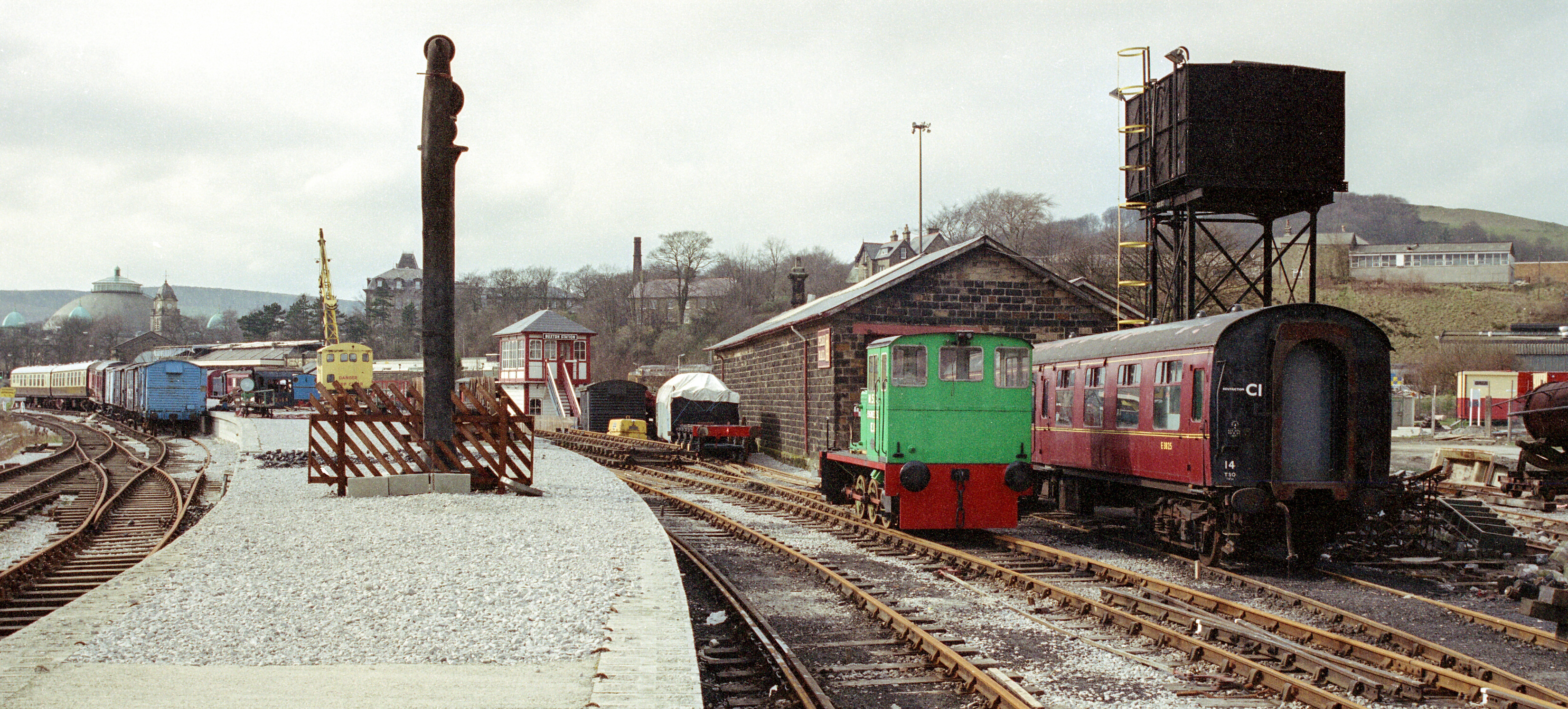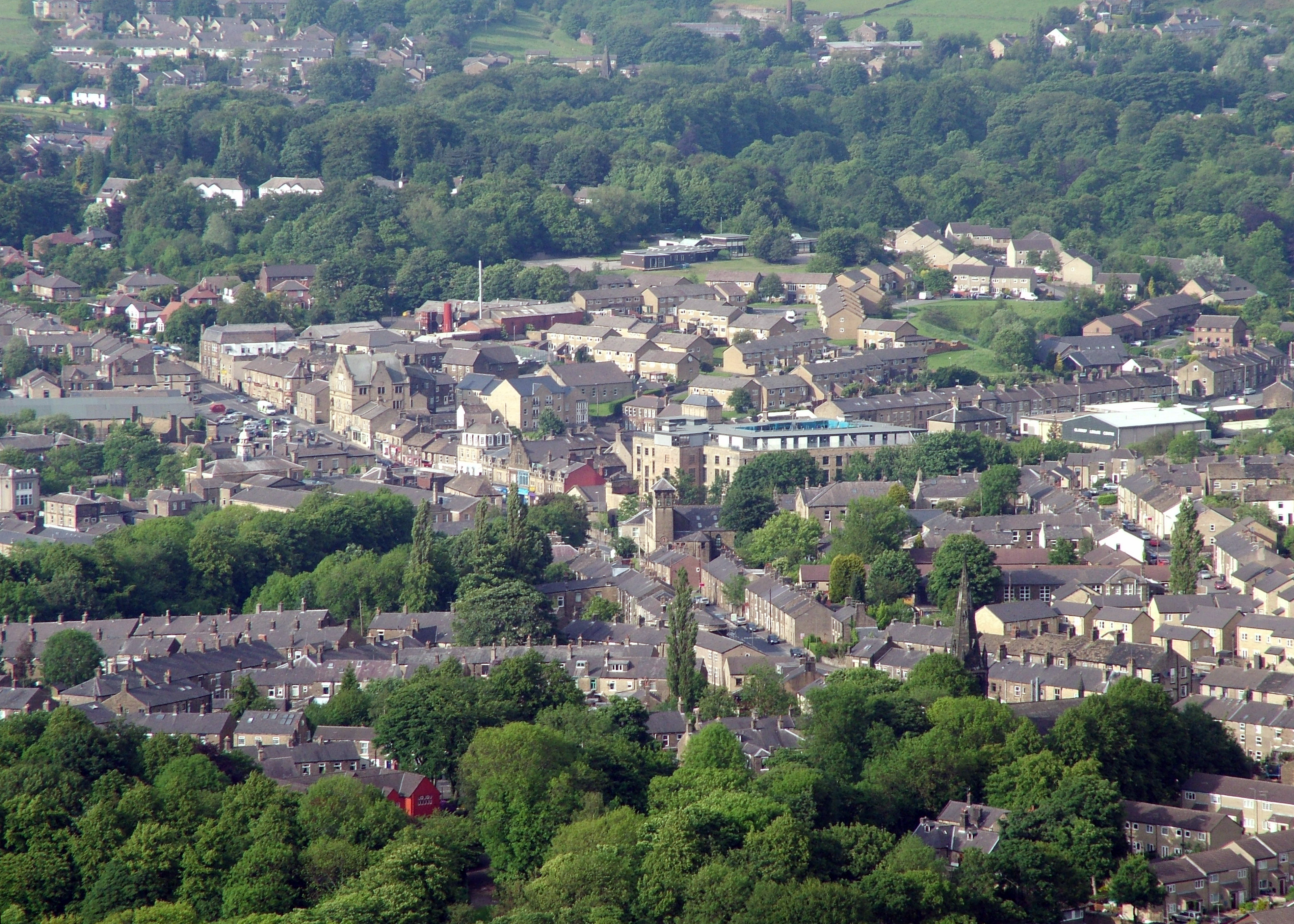|
Buxton Railway Station (Midland Railway)
Buxton (Midland) railway station served the town of Buxton, Derbyshire, England between 1863 and 1967. History The station was opened by the Midland Railway (MR) on 1 June 1863. It was adjacent to, and to the south-east of, the Buxton railway station of the Stockport, Disley and Whaley Bridge Railway, which opened two weeks later. The two stations had similar end walls incorporating a large fan-shaped window. The station was the terminus of the MR route from Derby. This route had opened as far as on 4 June 1849; and was continued to Buxton in 1863. The station was from . The station closed on 6 March 1967. Most of the station was subsequently demolished and the land used for a ring road. Part of the site including the trackbed of the tracks outside the station were occupied by the Buxton Steam Centre of the Peak Rail Peak Rail is a preserved railway in Derbyshire, England, which operates a steam and heritage diesel service for tourists and visitors to both the Peak ... [...More Info...] [...Related Items...] OR: [Wikipedia] [Google] [Baidu] |
Buxton
Buxton is a spa town in the Borough of High Peak, Derbyshire, England. It is England's highest market town, sited at some above sea level."Buxton – in pictures" , BBC Radio Derby, March 2008, accessed 3 June 2013. also claims this, but lacks a regular market. It lies close to to the west and to the south, on the edge of the |
Buxton Midland Former Station Site In 2019
Buxton is a spa town in the Borough of High Peak, Derbyshire, England. It is England's highest market town, sited at some above sea level."Buxton – in pictures" , BBC Radio Derby, March 2008, accessed 3 June 2013. Alston, Cumbria also claims this, but lacks a regular market. It lies close to to the west and to the south, on the edge of the [...More Info...] [...Related Items...] OR: [Wikipedia] [Google] [Baidu] |
Railway Stations In Great Britain Closed In 1967
Rail transport (also known as train transport) is a means of transport that transfers passengers and goods on wheeled vehicles running on rails, which are incorporated in tracks. In contrast to road transport, where the vehicles run on a prepared flat surface, rail vehicles (rolling stock) are directionally guided by the tracks on which they run. Tracks usually consist of steel rails, installed on sleepers (ties) set in ballast, on which the rolling stock, usually fitted with metal wheels, moves. Other variations are also possible, such as "slab track", in which the rails are fastened to a concrete foundation resting on a prepared subsurface. Rolling stock in a rail transport system generally encounters lower frictional resistance than rubber-tyred road vehicles, so passenger and freight cars (carriages and wagons) can be coupled into longer trains. The operation is carried out by a railway company, providing transport between train stations or freight customer facili ... [...More Info...] [...Related Items...] OR: [Wikipedia] [Google] [Baidu] |
Railway Stations In Great Britain Opened In 1863
Rail transport (also known as train transport) is a means of transport that transfers passengers and goods on wheeled vehicles running on rails, which are incorporated in tracks. In contrast to road transport, where the vehicles run on a prepared flat surface, rail vehicles (rolling stock) are directionally guided by the tracks on which they run. Tracks usually consist of steel rails, installed on sleepers (ties) set in ballast, on which the rolling stock, usually fitted with metal wheels, moves. Other variations are also possible, such as "slab track", in which the rails are fastened to a concrete foundation resting on a prepared subsurface. Rolling stock in a rail transport system generally encounters lower frictional resistance than rubber-tyred road vehicles, so passenger and freight cars (carriages and wagons) can be coupled into longer trains. The operation is carried out by a railway company, providing transport between train stations or freight customer facilit ... [...More Info...] [...Related Items...] OR: [Wikipedia] [Google] [Baidu] |
Former Midland Railway Stations
A former is an object, such as a template, gauge or cutting die, which is used to form something such as a boat's hull. Typically, a former gives shape to a structure that may have complex curvature. A former may become an integral part of the finished structure, as in an aircraft fuselage, or it may be removable, being using in the construction process and then discarded or re-used. Aircraft formers Formers are used in the construction of aircraft fuselage, of which a typical fuselage has a series from the nose to the empennage, typically perpendicular to the longitudinal axis of the aircraft. The primary purpose of formers is to establish the shape of the fuselage and reduce the column length of stringers to prevent instability. Formers are typically attached to longerons, which support the skin of the aircraft. The "former-and-longeron" technique (also called stations and stringers) was adopted from boat construction, and was typical of light aircraft built until the ad ... [...More Info...] [...Related Items...] OR: [Wikipedia] [Google] [Baidu] |
Manchester, Buxton, Matlock And Midland Junction Railway
The Manchester, Buxton, Matlock and Midland Junction Railway ran from a junction with the Midland Railway at Ambergate to Rowsley north of Matlock and thence to Buxton. In time it would become part of the Midland Railway's main line between London and Manchester, but it was initially planned as a route from Manchester to the East of England, via the proposed Ambergate, Nottingham, Boston and Eastern Junction Railway which would meet it a little further north along the North Midland line at Ambergate. The Act for a line from just south of Stockport to Ambergate was passed in 1846. Currently, the section north of Millers Dale is open as the Great Rocks freight line, Derby to Matlock still holds passenger services as the Derwent Valley line, Matlock to Rowsley is the Peak Rail heritage line, and Rowsley to Buxton has become the Monsal Trail for cycling, horse riding and walking. Ambergate to Rowsley The initial plan was for "An Act for making a Railway from the Manchester an ... [...More Info...] [...Related Items...] OR: [Wikipedia] [Google] [Baidu] |
Ian Allan Publishing
Ian Allan Publishing was an English publisher, established in 1942, which specialised in transport books. It was founded by Ian Allan. In 1942 Ian Allan, then working in the public relations department for the Southern Railway at Waterloo station, decided he could deal with many of the requests he received about rolling stock by collecting the information into a book. The result was his first book, ''ABC of Southern Locomotives''. This proved to be a success, contributing to the emergence of trainspotting as a popular hobby in the UK, and leading to the formation of the company.Ian Allan…the man who launched a million locospotters ''The Railway Magazine'' issue 1174 February 1999 pages 20-27 The company grew from a small producer of books for train enthusiasts and spotters to a large transport publisher. Each year it published books covering subjects such as military and civil aviation, naval and maritime topics, buses, trams, trolleybuses and steam railways, including hi ... [...More Info...] [...Related Items...] OR: [Wikipedia] [Google] [Baidu] |
Peak Rail
Peak Rail is a preserved railway in Derbyshire, England, which operates a steam and heritage diesel service for tourists and visitors to both the Peak District and the Derbyshire Dales. The preserved railway line is over 3½ miles (5.6 km) in length and, , operates train services from Matlock station (shared with Derwent Valley Line services from Derby via Ambergate) via the site of Matlock Riverside and Darley Dale to Rowsley South. Peak Rail intends to extend its operational services northward to when resources allow, extending to a total of 4¼ miles (6.8 km). Beyond Bakewell, the railway trackbed is used by the Monsal Trail. __TOC__ History First preservation attempts with the Buxton Steam Centre In 1975, the Peak Railway Preservation Society was established and opened a site at the now-closed Buxton Steam Centre with restoration facilities and a 300-yard operating line. Proposals were put forward to extend the operating line onto the single t ... [...More Info...] [...Related Items...] OR: [Wikipedia] [Google] [Baidu] |
High Peak, Derbyshire
High Peak is a local government district with borough status in Derbyshire, England. The borough compromises high moorland plateau in the Dark Peak area of the Peak District National Park. The district stretches from Holme Moss in the north to Sterndale Moor in the south, and from Hague Bar in the west to Bamford in the east. The population of the borough taken at the 2011 Census was 90,892. The borough is unusual in having two administrative centres for its council, High Peak Borough Council; the offices are based in both Buxton and Glossop. The borough also contains other towns including Chapel-en-le-Frith, Hadfield, New Mills and Whaley Bridge. High Peak was the name of a hundred of the ancient county of Derbyshire covering roughly the same area as the current district. It may have derived its name from the ancient Forest of High Peak, a royal hunting reserve administered by William Peverel, a favourite of William I, who was based at Peak Castle. High Peak contains much ... [...More Info...] [...Related Items...] OR: [Wikipedia] [Google] [Baidu] |
Stockport, Disley And Whaley Bridge Railway
The Stockport, Disley and Whaley Bridge Railway was an early railway company in England which was opened in 1857 between Stockport Edgeley and Whaley Bridge. Origins As early as 1828 when the Cromford and High Peak Railway and the Liverpool and Manchester Railway were still under construction, a Mr Thomas Legh had proposed in Stockport, that they could well be connected by a railway line from the former's terminus at Whaley Bridge. There were also number of other ideas for lines from London to meet the C&HPR at Cromford to reach Manchester. The main problem had been that of carrying passengers on the series of cable operated sections (see Derby station) In the next few years the route of the line was hotly contested by the three major railways of the time. The Manchester, Sheffield and Lincolnshire Railway had gained approval in 1848 for an extension of the Whaley Bridge branch of the Peak Forest Canal, which it owned, from Bugsworth to the tramway, with the eventual aim ... [...More Info...] [...Related Items...] OR: [Wikipedia] [Google] [Baidu] |
Buxton Railway Station (Derbyshire)
Buxton railway station serves the Peak District town of Buxton in Derbyshire, England. It is managed and served by Northern. The station is south east of Manchester Piccadilly and is the terminus of the Buxton Line. History Two railways arrived in Buxton almost simultaneously in 1863. The Stockport, Disley and Whaley Bridge Railway, heavily promoted by the London and North Western Railway (LNWR), built its line from Manchester to Whaley Bridge and extended it to Buxton. Meanwhile, the Midland Railway extended the Manchester, Buxton, Matlock and Midlands Junction Railway from Rowsley. When the Midland extended its main line to New Mills in 1867, to bypass the LNWR, Buxton became a branch line from Millers Dale. The two railways planned separate stations, but the town's leaders were concerned that the railway would damage the character of the place and requested that they be built side by side, and be in keeping with the existing architecture of the town. Consequently, the ... [...More Info...] [...Related Items...] OR: [Wikipedia] [Google] [Baidu] |








